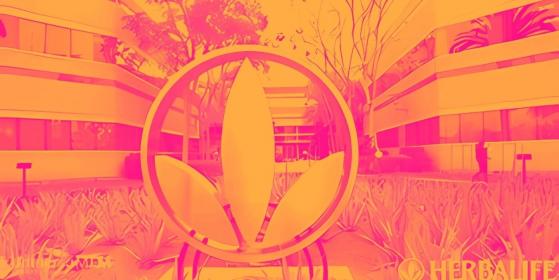Stock Story -
Health and wellness products company Herbalife (NYSE:HLF) reported results ahead of analysts' expectations in Q4 FY2023, with revenue up 2.9% year on year to $1.22 billion. It made a non-GAAP profit of $0.28 per share, down from its profit of $0.53 per share in the same quarter last year.
Is now the time to buy Herbalife? Find out by reading the original article on StockStory.
Herbalife (HLF) Q4 FY2023 Highlights:
- Revenue: $1.22 billion vs analyst estimates of $1.19 billion (2.2% beat)
- EPS (non-GAAP): $0.28 vs analyst expectations of $0.39 (29.1% miss)
- Free Cash Flow of $60.8 million, up 25.4% from the previous quarter
- Gross Margin (GAAP): 76.3%, up from 44.6% in the same quarter last year
- Organic Revenue was up 2.5% year on year
- Sales Volumes were down 2% year on year
- Market Capitalization: $1.17 billion
With the first products sold out of the trunk of the founder’s car, Herbalife (NYSE:HLF) today offers a portfolio of shakes, supplements, personal care products, and weight management programs to help customers reach their nutritional and fitness goals.
Personal CarePersonal care products include lotions, fragrances, shampoos, cosmetics, and nutritional supplements, among others. While these products may seem more discretionary than food, consumers tend to maintain or even boost their spending on the category during tough times. This phenomenon is known as "the lipstick effect" by economists, which states that consumers still want some semblance of affordable luxuries like beauty and wellness when the economy is sputtering.
As with other consumer staples categories, personal care brands must exude quality and be priced optimally given the crowded competitive landscape. Consumer tastes are constantly changing, and personal care companies are currently responding to the public’s increased desire for ethically produced goods by featuring natural ingredients in their products.
Sales GrowthHerbalife is larger than most consumer staples companies and benefits from economies of scale, giving it an edge over its smaller competitors.
As you can see below, the company's revenue has declined over the last three years, dropping 3% annually as consumers bought less of its products.
This quarter, Herbalife reported decent year-on-year revenue growth of 2.9%, and its $1.22 billion in revenue topped Wall Street's estimates by 2.2%. Looking ahead, Wall Street expects sales to grow 1.5% over the next 12 months, a deceleration from this quarter.
Volume GrowthRevenue growth can be broken down into changes in price and volume (the number of units sold). While both are important, volume is the lifeblood of a successful staples business as there’s a ceiling to what consumers will pay for everyday goods; they can always trade down to non-branded products if the branded versions are too expensive.
To analyze whether Herbalife generated its growth (or lack thereof) from changes in price or volume, we can compare its volume growth to its organic revenue growth, which excludes non-fundamental impacts on company financials like mergers and currency fluctuations.
Over the last two years, Herbalife's average quarterly volumes have shrunk by 8.5%. This isn't ideal for a consumer staples company, where demand is typically stable. In the context of its 3.8% average organic sales declines, we can see that most of the company's losses have come from fewer customers purchasing its products.
In Herbalife's Q4 2023, sales volumes dropped 2% year on year. This result was a step in the right direction compared to its 10.1% year-on-year decline 12 months ago.
Key Takeaways from Herbalife's Q4 Results We were impressed by how significantly Herbalife blew past analysts' organic revenue growth expectations this quarter, driven by outperformance in its Asia and North America segments. On the other hand, its operating margin and EPS missed Wall Street's estimates. Overall, this was a mediocre quarter for Herbalife. The stock is flat after reporting and currently trades at $11.69 per share.
